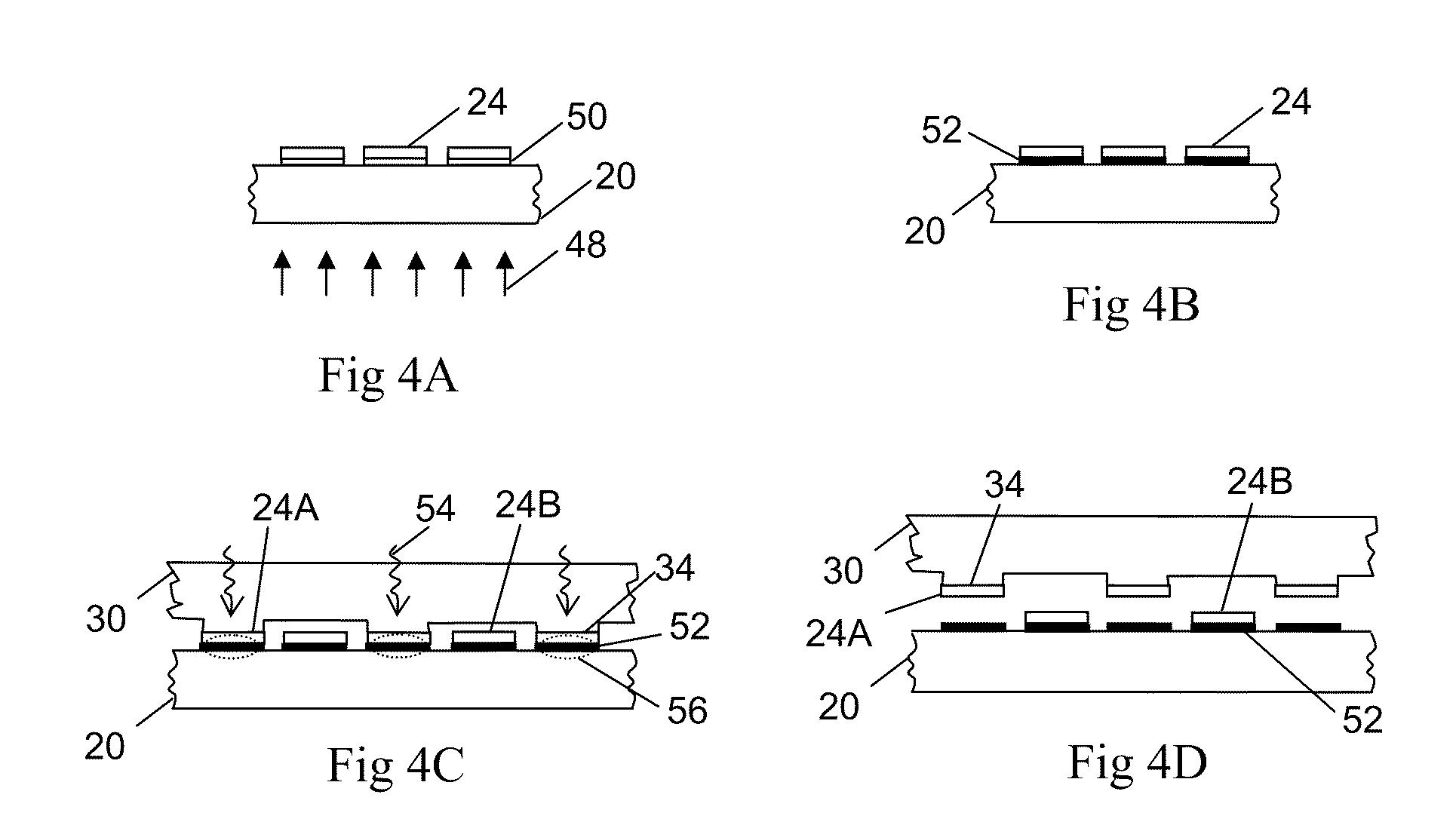Method of manufacturing transferable elements incorporating radiation enabled lift off for allowing transfer from host substrate
a technology of transferable elements and lift off, which is applied in the manufacture of semiconductor/solid-state devices, electrical apparatus, semiconductor devices, etc., can solve the problems of decomposition and/or weakening of the interfacial layer or sacrificial layer, and achieve the effect of avoiding the use of silicon wafer as a host substra
- Summary
- Abstract
- Description
- Claims
- Application Information
AI Technical Summary
Benefits of technology
Problems solved by technology
Method used
Image
Examples
first exemplary embodiment
of Method
Single Step Radiation Lift Off to Stamp
[0064]Referring to FIG. 2A, in the first exemplary embodiment of the manufacturing method a host substrate 20 is provided. The host substrate 20 is formed of a material, such as sapphire or the like, exhibiting substantial optical transparency to radiation, such as UV light, as described above. An epitaxial layer 21, which may include one or more layers, is grown on the host substrate 20 and processed and formed, for example, by using the well-known patterning and etching techniques, into semiconductor die 24 disposed on the host substrate 20 as shown in FIG. 2B. While square semiconductor die 24 have been shown, other shapes are possible, including rectangular, hexagonal, circular, polygonal, regular, irregular, compound or slotted. FIG. 2C depicts a partial view of the host substrate 20 with semiconductor die 24 that have each been metalized with n contact areas 26 and p contact areas 28. In one example the semiconductor die may have...
second exemplary embodiment
of Method
Two Step Laser Radiation Lift Off
[0075]In a second exemplary embodiment of the manufacturing method it is possible to decompose the GaN layer during the irradiation step while not releasing the semiconductor die 24A from the host substrate 20. In this embodiment irradiation of the interface layer decomposes the GaN into N2 gas and metallic Ga. The metallic gallium present in the interface layer continues to bind the semiconductor die 24A to the host substrate 20. In a second step subsequent application of a temperature sufficient to melt the gallium layer will then allow for the release of the semiconductor die. Due to the relatively low melting point of gallium, this temperature could be in the region of 30° C.
[0076]FIGS. 4A-4D illustrate this two step laser lift off technique employed in the second exemplary embodiment of the method of the present invention. Initially, the host substrate 20, made of optically transparent material, such as sapphire, is prepared with an epi...
third exemplary embodiment
of Method
Maintaining Semiconductor Die Location
[0078]In a third exemplary embodiment of the manufacturing method of the present invention, which is a variation of the above-described two step process, the entire wafer may be heated to a sufficient temperature to allow for reflow of the gallium layer 52. The stamp 30 may be configured to pick up semiconductor die 24A, as described above; but in order to control the position of the semiconductor die, several solutions are described hereinafter, with reference to FIGS. 5A-5F.
[0079]In FIG. 5A, a variation is shown where an optical system is used with the laser such that every second semiconductor die 62 is irradiated. Even if only some of these semiconductor die 62 are to be transferred to a stamp, or other substrate, the ones that are not picked up are restrained in sideways movement by the adjacent semiconductor die 64 that are still on a layer of solid gallium. The width d of the trenches 66 between the semiconductor die 62, 64 can b...
PUM
 Login to View More
Login to View More Abstract
Description
Claims
Application Information
 Login to View More
Login to View More - R&D
- Intellectual Property
- Life Sciences
- Materials
- Tech Scout
- Unparalleled Data Quality
- Higher Quality Content
- 60% Fewer Hallucinations
Browse by: Latest US Patents, China's latest patents, Technical Efficacy Thesaurus, Application Domain, Technology Topic, Popular Technical Reports.
© 2025 PatSnap. All rights reserved.Legal|Privacy policy|Modern Slavery Act Transparency Statement|Sitemap|About US| Contact US: help@patsnap.com



